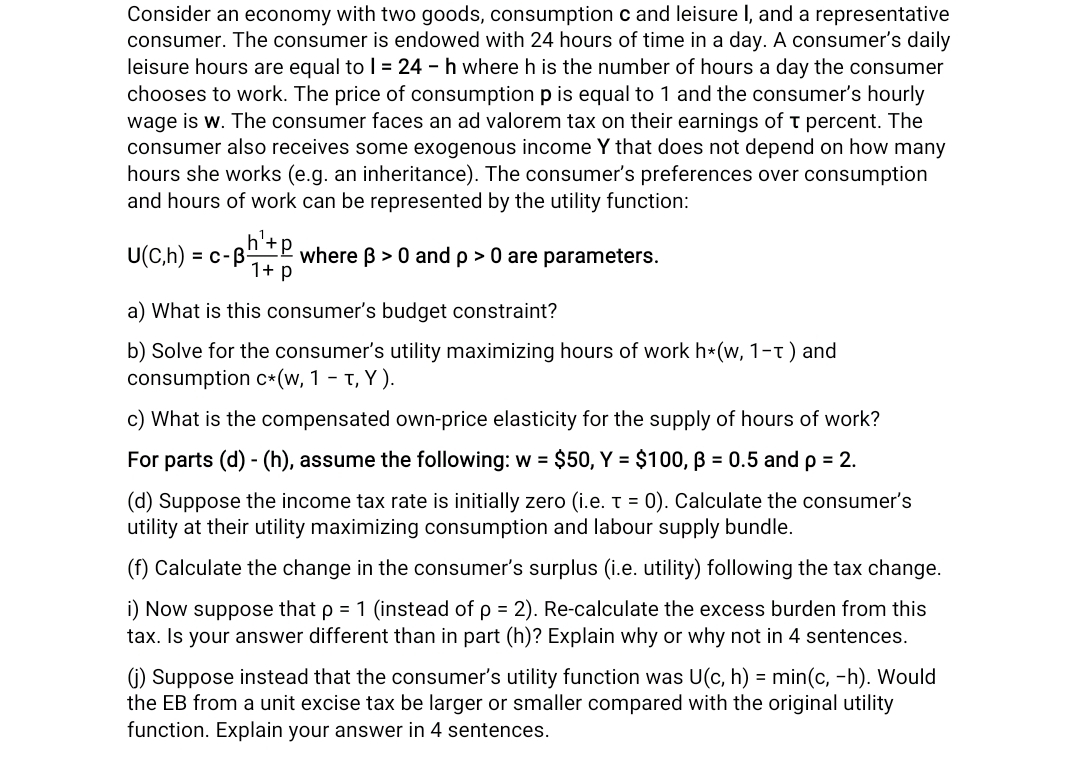Consider an economy with two goods, consumption c and leisure I, and a representative consumer. The consumer is endowed with 24 hours of time in a day. A consumer's daily leisure hours are equal to 1 = 24-h where h is the number of hours a day the consumer chooses to work. The price of consumption p is equal to 1 and the consumer's hourly wage is w. The consumer faces an ad valorem tax on their earnings of τ percent. The consumer also receives some exogenous income Y that does not depend on how many hours she works (e.g. an inheritance). The consumer's preferences over consumption and hours of work can be represented by the utility function: n'+p 1+ P U(C,h) = c-B where ß> 0 and p > 0 are parameters. a) What is this consumer's budget constraint? b) Solve for the consumer's utility maximizing hours of work h*(w, 1-T) and ( 1
Consider an economy with two goods, consumption c and leisure I, and a representative consumer. The consumer is endowed with 24 hours of time in a day. A consumer's daily leisure hours are equal to 1 = 24-h where h is the number of hours a day the consumer chooses to work. The price of consumption p is equal to 1 and the consumer's hourly wage is w. The consumer faces an ad valorem tax on their earnings of τ percent. The consumer also receives some exogenous income Y that does not depend on how many hours she works (e.g. an inheritance). The consumer's preferences over consumption and hours of work can be represented by the utility function: n'+p 1+ P U(C,h) = c-B where ß> 0 and p > 0 are parameters. a) What is this consumer's budget constraint? b) Solve for the consumer's utility maximizing hours of work h*(w, 1-T) and ( 1
Chapter17: Capital And Time
Section: Chapter Questions
Problem 17.1P
Related questions
Question

Transcribed Image Text:Consider an economy with two goods, consumption c and leisure I, and a representative
consumer. The consumer is endowed with 24 hours of time in a day. A consumer's daily
leisure hours are equal to 1 = 24 - h where h is the number of hours a day the consumer
chooses to work. The price of consumption p is equal to 1 and the consumer's hourly
wage is w. The consumer faces an ad valorem tax on their earnings of T percent. The
consumer also receives some exogenous income Y that does not depend on how many
hours she works (e.g. an inheritance). The consumer's preferences over consumption
and hours of work can be represented by the utility function:
U(C,h) = c-B- where ß> 0 and p > 0 are parameters.
‚h¹- P
1+ p
a) What is this consumer's budget constraint?
b) Solve for the consumer's utility maximizing hours of work h*(w, 1-T) and
consumption c* (w, 1 - T, Y).
c) What is the compensated own-price elasticity for the supply of hours of work?
For parts (d) - (h), assume the following: w = $50, Y = $100, ß = 0.5 and p = 2.
(d) Suppose the income tax rate is initially zero (i.e. t = 0). Calculate the consumer's
utility at their utility maximizing consumption and labour supply bundle.
(f) Calculate the change in the consumer's surplus (i.e. utility) following the tax change.
i) Now suppose that p = 1 (instead of p = 2). Re-calculate the excess burden from this
tax. Is your answer different than in part (h)? Explain why or why not in 4 sentences.
(j) Suppose instead that the consumer's utility function was U(c, h) = min(c, -h). Would
the EB from a unit excise tax be larger or smaller compared with the original utility
function. Explain your answer in 4 sentences.
Expert Solution
This question has been solved!
Explore an expertly crafted, step-by-step solution for a thorough understanding of key concepts.
This is a popular solution!
Trending now
This is a popular solution!
Step by step
Solved in 3 steps

Knowledge Booster
Learn more about
Need a deep-dive on the concept behind this application? Look no further. Learn more about this topic, economics and related others by exploring similar questions and additional content below.Recommended textbooks for you

